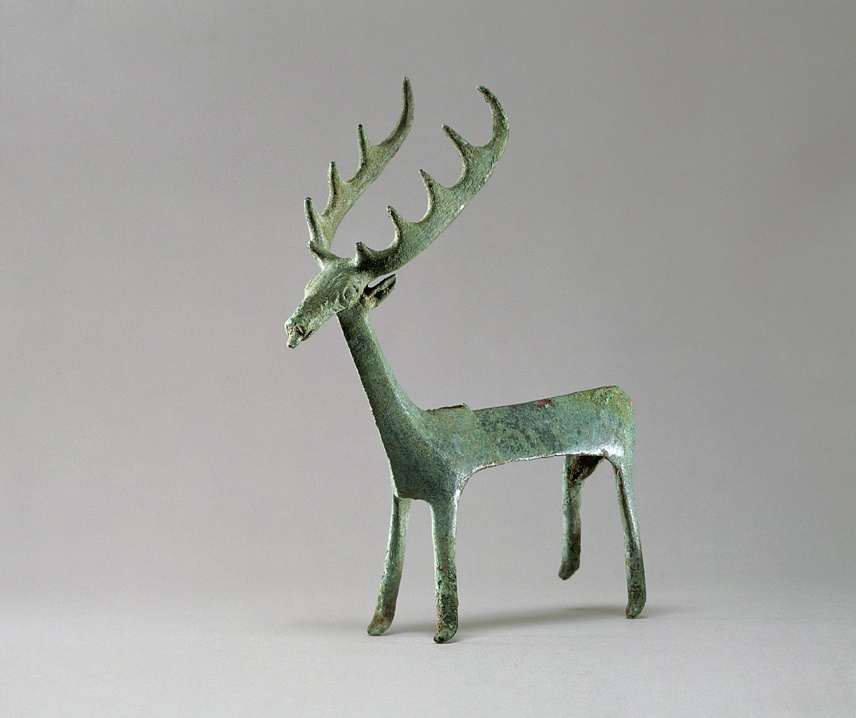
Bronze
H: 14.4 cm. L: 13.7 cm
Allegedly from around the southern part of Lake Bolsena Nuragic
10th-8th century B.C.?
Cast by the lost wax method, polished and worked in the cold. A slit between the shoulders on back to enable mounting.
Condition: patina a pale green with some traces of grey metal surface showing through, the odd spot of cuprite and whitish green cuprous chloride. Tip of snout, lower left front leg, part of rump and right leg cracked with brown earth incrustations.
The front left leg bent outwards, the body slightly contorted resulting in some distortion to the right hind leg. A small gash to the upper inside of right leg and two nicks on rear underside of body.
This stag served as a finial for a votive sword [1]. As such, it not only enhanced the importance of the offering but surely added a note of sacredness and magic to the sword, rendering the offering more ingratiating. Possibly it in part fulfilled a similar function to the Anatolian stag finial, cat. no. 28, though in a different context.
For the style, there is a distant family resemblance to a bull [2] in Cagliari for the body construction, neck and legs and a very distant rapport with two other bulls [3] also in Cagliari. Closer comparisons are the groups of a stag and dog [4] and of double-protome stags (votive finials on the end of long swords), and particularly two [5] in Cagliari, with tongues protruding as on our stag.
Considering the stag's alleged provenance from the southern Villanovan area, he is probably from a Villanovan tomb of the 1st or 2nd Benacci period around the first quarter of the 1st millennium.
Exhibited and Published:
Kunst Sardiniens, cat. no. 151, pp. 396, 309 ill., p. 236 col. pl. (Thimme, J. Altsardische Kunst, Bildhefte des Badischen Landesmuseums Karlsruhe, 1980, p. 27 ill. 17. )
Archaeology Glossary
1 These were wont to be long and slender, e.g. the one in the author's collection, L: 126.8 cm (Thimme, J.: Kunst Sardiniens, no. 201 pp. 409, 336 ill.), and three swords composing a trophy, L: 127 and 129 cm, Sassari, National Museum 2050 (Thimme, J.: loc. cit., no. 202).
2 National Archaeological Museum: Lilliu, G.: Sculture della Sardegna nuragica (Verona, 1966), no. 209, pp. 329-330.
3 National Archaeological Museum: Lilliu, G.: op. cit., no. 210, pp. 330-331; no. 212, p. 331.
4 Karlsruhe, Badisches Landesmuseum: Thimme, J.: op. cit., no. 149, pp. 395-396, 307 ill.
5 National Archaeological Museum: Lilliu, G.: op. cit., nos. 253, 257, pp. 362-364.